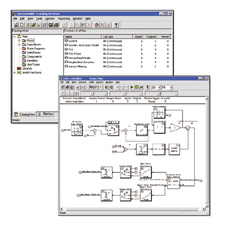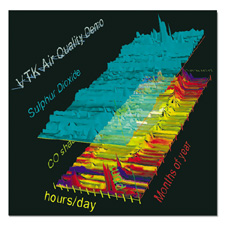Latest News
June 1, 2004
By Alan Joch
Over the last decade, there has been a sea change in the skill sets of designengineers working for large manufacturing companies. Automobiles and aircraftare getting “smarter,” thanks to embedded computer control systems in everythingfrom engines to braking systems. So when an engineering workgroup sits down tocreate one of these components, it finds there’s more to do than just the mechanicaldesign work.
 Depicted here is an antenna array field pattern. This webMathematica image showsthe array factor for a linear array excited with uniform voltages of uniform interelementphasing. Image courtesy of Wolfram Research, Inc.
Depicted here is an antenna array field pattern. This webMathematica image showsthe array factor for a linear array excited with uniform voltages of uniform interelementphasing. Image courtesy of Wolfram Research, Inc.
“Having to do different types of analyses,” says Roger Germundsson, directorof research and development for Wolfram Research in Champaign, Illinois, “includingfor signal processing elements, is taking on a bigger and bigger part of theirRandD budget.”
Germundsson’s company, maker of the data modeling and visualization applicationMathematica, along with a host of other companies, is targeting the data analysisneeds of this segment of the engineering industry. For example, Mathematica nowcan be enhanced with custom performance packs, add-on programs to analyze mechanicalsystems, and control engineering applications.
As a result of efforts like these, and similar ones from National Instruments,Visual Numerics, and others, designers have a wider range of data-analysis choices,with applications that can quickly model, graph, and simulate the performanceof critical systems and components.
 This pair of PV-Wave 75 simulations provides a visualization of gas turbinetest data and the mathematical model. Image courtesy of Visual Numerics, Inc.
This pair of PV-Wave 75 simulations provides a visualization of gas turbinetest data and the mathematical model. Image courtesy of Visual Numerics, Inc.
Managing Variables Modeling applications are much more than tools to turn numbers into charts, likethe simple representations that spreadsheet programs create. For example, PV-Wavefrom Visual Numerics Inc. (VN) of San Ramon, California, provides a fourth-generationprogramming language and a scripting environment so engineers can perform andgraphically represent sophisticated data analyses, including time-series sequences.Aerospace firms can use analytics like these to simulate air flow over a wingand to test engine designs, while plugging in different data parameters to representvarying environmental conditions. “Aerospace firms need visualization and rapidprototyping to get a quick look at their data,” says Phil Fraher, VN’s chief operatingofficer.
Engineers creating aircraft designs can include hundreds of variables in modelingsoftware at the same time: altitude, g-force, speed, and the weight of fuel ina tank. “It allows engineers to simulate and experiment in much more detail thanever before, and test as many scenarios as possible,” Fraher says.Similarly, automakersfind themselves collecting huge amounts of data from test drives. These evaluationsrecord data from a variety of makes and models of vehicles, which are equippedwith data-gathering systems and then driven in rural and urban settings underchanging traffic conditions. The result is a mass of data with interdependentvariables, and the challenge lies in getting a handle on all of this information.Data analysis platforms, like PV-Wave, turn that mass of raw statistics into graphsand plots that can then inform future engineering designs.
National Instruments MATRIXx 7.1 introduces better debugging, model managementand automatic code generation to accelerate design of dynamic control systems.With a MATRIXx model-based design approach, aerospace and automotive design engineerscan rapidly construct and manage large models, perform simulations, develop andtest control logic and automatically generate code for prototyping and embeddeddeployment. Image courtesy of National Instruments.
In the future, modeling software will rely more and more on the sophisticatedgraphics cards that push the performance of desktop computer systems. The onboardgraphics processors on these cards free the computer’s CPU of doing all the graphicsprocessing. By offloading these chores to the video card, engineers can do renderingsin real time using OpenGL.
“Real-time rendering buys you better interaction with your data,” says Ed Stewart,sales engineer manager with VN. “I can click in this window, spin it around, lookat surfaces from different angles, and really dig into my 3D data.”
Web Services on the RiseAt Wolfram Research, Web services will help define the future. In one incarnation,Web services will target client-side applications. By doing so, Web-based applications,such as search engines, will plug into Mathematica so that they become anotherfunction within the platform’s data analysis, visualization, and reporting functions.Thus, an engineer may collect citations for a list of research reports on enginedesigns pulled down from a Web search, and then represent the results as a chartor graph.
Not to be ignored are server-side Web services, which also will grow in importanceaccording to Wolfram’s vision. These services will allow engineers to write mathematicscode for a specific problem or project and store the code as a small softwareprogram on a Web server. Server-side service software stored in this central locationmeans that designers throughout the company are then able to access the program’sanalytical capabilities for use in related projects. “Any Web service on the plantbecomes available to everyone in the enterprise,” Germundsson says.
One large agricultural equipment manufacturer already uses this capability topublish about 20 different engineering specifications related to tractor linkages.“An RandD group has the responsibility for designing linkages that don’t runinto themselves,” Germundsson explains. “It’s a tough problem, and when they designa system, they build software that can then be propagated out into the organization"as a server-side Web service.
Embedded IntelligenceMATRIXx from National Instruments Corporation in Austin, Texas, is intended toaddress the embedded controller needs of design engineers. According to ProductManager Greg Wempe, MATRIXx will do this by providing tighter integration withhardware-based testing platforms.
“Running your control logic on an actual ECU ]electronic control unit] can beexpensive when it’s a one off,” he says, referring to the cost of producing prototypes.“We find customers doing rapid control prototyping tests by taking ECU code anddropping it onto a test platform. In the future we’ll offer more integration betweenMATRIXx and these hardware test platforms.”
MATRIXx is a niche product for engineers who have to design control logic andembedded controllers. It provides a platform for using software models and simulationsto show how an engine or another component might function under a variety of drivingconditions. The software models the engine and then gives engineers a tool todevelop the motor’s control logic. The platform can also automatically generatecode to embed onto an ECU.
“We want to give engineers a graphical model that provides the same inputs andoutputs as an actual engine,” Wempe explains. To do this, engineers use the graphicalmodeling environment to string together blocks that represent different mathematicalfunctions, which combine to provide the specific behavioral characteristics ofthe engine.
National Instruments expects to broaden its user base in the coming year. “Designengineers often have the guy on other side of wall, the computer scientist, whowrites the actual test code,” says Wempe. “We’re enabling design engineers todo testing on their own desktop without having to use a computer-code engineer.”
This means that design engineers can go further in the design and testing processwithout having to pass off technical pieces to someone else.

An air quality time series analysis. Image courtesy of Visual Numerics, Inc.
Controlling Complexity Ironically, the skill with which modeling and graphing programs create visualrepresentations isn’t just for engineering data. These capabilities become importantfor helping engineers wade through the complexities of the modeling programs themselves.
“Engineers particularly don’t always know what model they need to use when theygo into a system that’s very complex,” says Ron Brown, chief technology officerwith Systat Software Inc. of Point Richmond, California. For help, engineers canenter statistical criteria into the programs and let the software rate the longlist of modeling choices to find the best fit for each individual project.
“Computers are capable of doing a massive amount of that work for you,” Brownexplains. “Just give someone a graphical review of the models,show what the pitfallsare of one model versus another, and the engineer will pick the one that’s right.“And in so doing, graphing and modeling programs are achieving their larger goalAdds Brown: “In terms of the analytic world we live in, it’s going to get moreand more complex, and as it does, one of the things we deal with on the softwareside is managing that complexity.”
Sea change, it appears, is an ongoing phenomenon.
Alan Joch is a business and technology writer based in New England. You can offer him feedbackabout this article through Reader feedback.
Companies Mentioned in Article
Subscribe to our FREE magazine, FREE email newsletters or both!
Latest News
About the Author
DE’s editors contribute news and new product announcements to Digital Engineering.
Press releases may be sent to them via [email protected].






